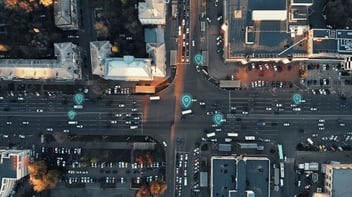

The Most Common LPWAN Use Cases
The diversity of LPWAN technologies allows for its application across various domains, driving innovation and transforming industries. Each technology has its own features, advantages, and deployment scenarios. IoT applications need to choose the most suitable option based on their requirements. The following are the prominent technologies along with their key functional differences:
1. LTE-M:
- Operates in licensed spectrum.
- Cost-effective solution utilising existing LTE infrastructure.
- Improved signal penetration for connectivity in obstructed areas.
- Low latency for faster response times.
2. NB-IoT:
- Operates in the licensed spectrum.
- Offers deep indoor penetration and wide coverage.
- Provides higher data rates compared to other LPWAN technologies.
- Offers strong security features and seamless integration with existing cellular networks.
3. LoRaWAN:
- Operates in unlicensed spectrum.
- Provides long-range communication with low power consumption.
- Offers flexible deployment options (public, private, or hybrid networks).
- Supports bi-directional communication for device-to-cloud and cloud-to-device interactions.
4. Sigfox:
- Operates in unlicensed spectrum.
- Provides a long-range connection with less power consumption.
- Offers low-cost modules and reduced device complexity.
- Provides limited uplink and downlink data transfer capacity.
5. Weightless SIG (Special Interest Group):
- Supports both licensed and unlicensed spectrum.
- Provides wireless connection to the devices involved in an IoT solution.
- Offers a range of deployment options, including wide-area and local-area networks.
- Provides support for mobility and roaming.
6. Ingenu (RPMA- Random Phase Multiple Access):
- Operates in licensed spectrum.
- Provides long-range connectivity with high capacity.
- Offers robust network performance and reliability.
- Provides strong interference immunity and security features.
It is clearly evident that the above-stated technologies share some common features, such as prolonging device battery life. However, there are different factors to consider when deciding when to implement one of the above technologies. Let us explore some of the most common LPWAN applications across the industries below.
Smart Urban Living
LPWAN can be used in a wide range of smart city applications. The common LPWAN smart city use cases include the following:
- Smart parking solutions
- Health monitoring of buildings to ensure their stability and safety
- Air quality measurement systems,
- Sound noise level measurement for noise control and mitigation
- Smart lighting systems for energy-efficient lighting
- Optimise trash collection routes for efficient waste management
- Elevator monitoring and control for enhanced safety and maintenance
- Construction equipment and health monitoring for improved worker safety and many others.
Retail
In the retail sector, LPWAN is transforming various aspects of the industry. For example, optimising supply chain control systems, logistics, and distribution processes to ensure efficient and timely delivery of products. Used in smart shelves with sensors and RFID technology to provide fast inventory tracking. Which enables retailers to manage stock levels and minimise out-of-stock situations efficiently.
Industrial Manufacturing and Automation
M2M (Machine-to-Machine) applications leverage LPWAN to enable seamless communication and data exchange between iot devices, enhancing automation and efficiency. Production line monitoring applications is using LPWAN to track and optimise manufacturing processes, improving productivity and quality control. Localising assets becomes feasible, enabling efficient tracking and monitoring of valuable resources within a confined space.
Moreover, LPWAN is making the concept of machine and factory-as-a-service possible, which enables remote monitoring, management, and optimisation of machines and factories.
Smart Agriculture and Environment
Another LPWAN use case is Smart Agriculture. Use LPWAN to monitor and maintain optimal environmental conditions for diverse industries.
Such as enabling smart greenhouses to monitor and automate the control of environmental parameters, and optimising crop growth and productivity remotely. Achieving agricultural automation through remote operation and data exchange for efficient farm management. Helping monitor and track livestock remotely for their health, location, and behaviour, ensuring efficient control and welfare.
eHealth
LPWAN has a profound impact on the healthcare industry and is suitable in multiple healthcare use cases for patient well-being. Through the connectivity of LPWAN, various medical devices and systems can be integrated to enable seamless data exchange with improved reliability. LPWAN can be crucial in assisted living environments, enabling remote monitoring and support for individuals with health conditions.
Considering the above LPWAN applications, it is important to prioritise one attribute of certain LPWAN technologies over the other.
For example, a soil monitoring solution deployed in a remote area may need to transmit data to longer distances and be energy efficient. In this case, it is best to deploy LoRaWAN and NB-IoT.
In another instance, when needs remote patient monitoring and transmitting data with low latency rates, LoRaWAN, NB-IoT or a combination of these technologies can be used.
The choice of LPWAN technologies should be based on a detailed analysis of specific application requirements, such as range, power consumption, data rates, and deployment options. In addition, IoT businesses must also consider available infrastructure, cost, and regional availability of network coverage to determine the right LPWAN technology for their specific use cases.
Speak to a Velos IoT expert
Related articles


LTE-M vs NB-IoT: What are the differences?
When it comes to LPWAN options for IoT businesses, two LPWAN technologies stand out: LTE-Mand...

Green Urbanism: How LPWAN Drives Sustainability
Low-Power Wide-Area Network (LPWAN) technology is a cornerstone for sustainable urban development,...
